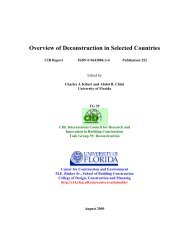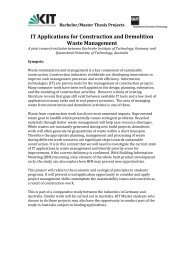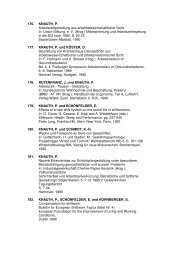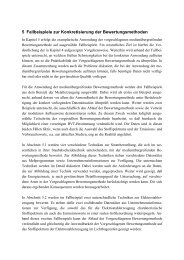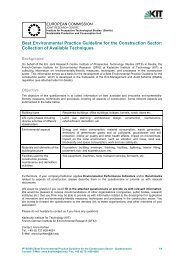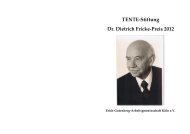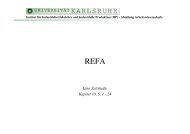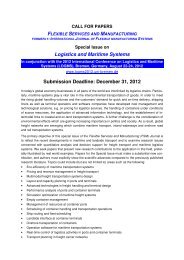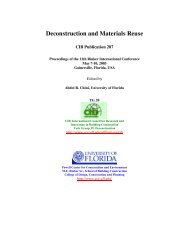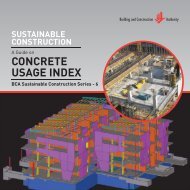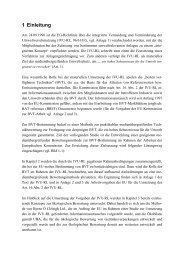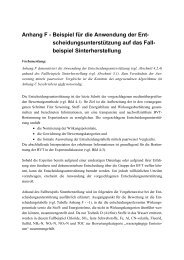Waste reduction final report -4 - Test Input
Waste reduction final report -4 - Test Input
Waste reduction final report -4 - Test Input
Create successful ePaper yourself
Turn your PDF publications into a flip-book with our unique Google optimized e-Paper software.
Discussion<br />
The previous two chapters showed types and amounts of waste, its treatment and the most<br />
important secondary materials and their use.<br />
Whilst recycling is very well known and established in civil engineering, the diversity and<br />
therefore complexity of materials is much higher in house building. Besides the “big”<br />
categories such as bricking or concrete, there are many other incorporated in a building –<br />
unfortunately often in compounds and treated with chemicals, what makes them impossible<br />
to separate (or impossible to do this economically) and problematic in view of pollutants.<br />
Still, selective demolition could be a solution to the big flow of house building waste today<br />
incinerated or landfilled. There have already been made many tests on how this can be done<br />
and if it is economically feasible [EU 1999, Mesch and Baumann 2003, Roussat, et al. 2009,<br />
Wien 2004]. Results say that this method is highly positive for waste management and<br />
treatment. Costs vary much from case to case, so it cannot be said that selective demolition is<br />
sustainable in each case from the economical point of view. However, it is highly<br />
recommended to consider this type of demolition in deliberations. In Switzerland, gutting is<br />
made in many demolition activities, i.e. wooden parts, metals, floorings, plastics etc. are<br />
taken out as far as possible before tearing down the building envelope. Unfortunately, a<br />
possible reuse of elements such as windows, doors, heaters is often difficult because of fast<br />
developing technologies.<br />
<strong>Waste</strong> materials coming from house building are seen to have contaminants and impurities.<br />
These prejudices have to be eliminated where solutions have already been found.<br />
3. Strategies, guidance documents<br />
This chapter presents main strategies or guidance documents which could mitigate<br />
construction waste. At the beginning, the Sustainable Development Strategy of the Swiss<br />
federal government is introduced. Strategies are then divided into building strategies<br />
concerning design problems; reuse and recycling strategies to decrease disposal or<br />
incineration; and disposal strategies which aim at abating incentives for landfilling. After this,<br />
important Swiss associations in the recycling of construction material industry are shortly<br />
presented, followed by an overview on available Life Cycle Assessment (LCA) instruments.<br />
Sustainable Development Strategy, Switzerland<br />
The Swiss Federal Council adopted the first Sustainable Development Strategy (SDS) in<br />
1997 and established the second one in 2002. After a revision in 2007, Switzerland is now<br />
working on the action plan 2008-2011.<br />
The guidelines are rooted in the Swiss Federal Constitution as well as in reference documents<br />
and strategies issued by the United Nations, the OECD and the EU.<br />
In order to establish close links between legislative planning and the SDS, the Federal<br />
Council has derived eight key strategic priority challenges that form the basis of its action on<br />
sustainable development 32 . An Interdepartmental Sustainable Development Committee aims<br />
to significantly intensify the assessment and optimization of political projects from the<br />
32 These strategies refer to: Climate change and natural hazards; Energy; Spatial development and<br />
transport; Economy, production and consumption; Use of natural resources; Social cohesion, demography<br />
and migration; Public health, sport and the promotion of physical exercise; Global developmental and<br />
environmental challenges; Fiscal policy; Education, research and innovation; Culture<br />
106



